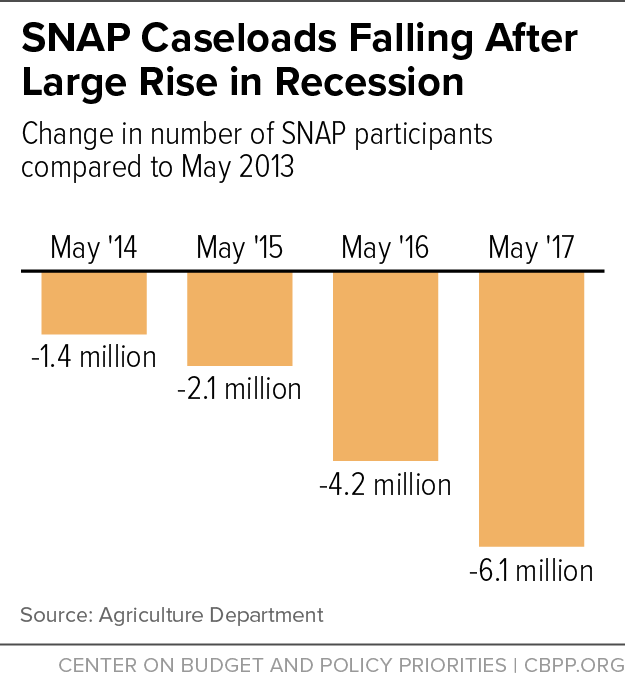BEYOND THE NUMBERS
The number of SNAP (formerly food stamp) participants continued falling in May, to 41.5 million — down 6.1 million since May 2013 (see graph) and 6.3 million or 13 percent since peaking in December 2012. For nearly four years, SNAP participation each month has been lower than in the same month the previous year. Falling caseloads are helping to shrink SNAP spending as well.
One of SNAP’s greatest strengths is its responsiveness to economic change. As poverty rises and need increases, as during the Great Recession of 2007-09, more people become eligible for SNAP and a greater share of eligible people turn to it to help feed their families. Also, states have become more effective at serving eligible people, which helped fuel an increase in SNAP’s participation rate among eligible people from 69 percent in 2007 to 85 percent in 2013, declining only slightly to 83 percent in 2014 and 2015.
SNAP typically shrinks as the economy improves, which is likely the main reason why SNAP caseloads have fallen steadily in recent years in nearly every state. In many states, the return of SNAP’S three-month time limit on benefits for unemployed childless adults has been a factor as well.
SNAP spending is also falling. Spending for the first ten months of this fiscal year (October 2016 through July 2017) was 4 percent lower than in the first ten months of last fiscal year. The Congressional Budget Office predicts that total spending (in nominal dollars, not adjusted for inflation) will fall by about 4 percent for the year as a whole and another 4 percent in 2018.
While declining caseloads are a major driver behind falling SNAP costs, a benefit reduction due to lower food prices will also contribute to falling costs in 2018. SNAP benefit levels are based on the cost of the Agriculture Department’s Thrifty Food Plan, which reflects the minimal cost of a bare-bones, nutritionally adequate diet. A family with zero net income (income minus deductions for expenses such as rent and child care) receives the maximum benefit, which equals the full value of the TFP. Due to declines in the TFP, SNAP’s maximum benefit will fall in nearly every state in 2018. (The exception is Hawaii, where the maximum benefit will go up.) For example, the maximum benefit for a family of four in the contiguous United States will fall from $649 per month in fiscal year 2017 to $640 in fiscal year 2018.
Not all households receive the maximum benefit, and other parts of the benefit calculation (such as the standard deduction and maximum shelter deduction) will rise next year to reflect inflation in other parts of the economy, so not all SNAP households will experience the same benefit reduction. Close to three-quarters of households will see a modest reduction of about $4 per month; the rest will have no change or a modest increase. These slightly lower benefit levels, combined with declining participation, will contribute to declining costs in 2018.

